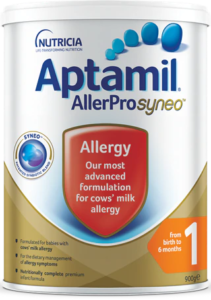Prebiotics, probiotics and synbiotics in infant formula

The World of Infant Formula Has Been Redefined.
Breast milk the gold standard of nutrition
Breast milk is the optimal form of infant nutrition and serves as a model for infant formula – which provides nutritional solutions for infants unable to receive enough mother’s milk.
The benefits of breastfeeding to the immune system
Nutrition in the first 1,000 days (from preconception to the 2nd year of life) is one of the most crucial factors in infant immune, gut and brain development 1. The WHO recommends exclusive breastfeeding for the first 6 months of life, continuing up to 2 years and beyond with gradual introduction of safe and suitable complementary feeding2.
1. Kramer MS & Kakuma R. Optimal duration of exclusive breastfeeding (Review). WHO (2001)
2. Gluckman PD & Hanson MA. Developmental Origians of Disease Paragidgm: A Mechanistic and Evolutionary Perspective (Review Article). Pediatric Research 56(3), 312-317 (2004)
The unique composition of breast milk
The unique composition of breast milk – including its human milk oligosaccharides (HMOS), immune cells, bacteria, and bacteria metabolites – support infant growth and development by promoting a healthy gut microbiota which is of significant importance during infancy. One of the major factors enabling proper gut function and development is a balanced gut microbiota. Several prenatal and perinatal factors including mode of delivery, use of antibiotics, diet, and other environmental factors, including geographic region, may influence the microbial colonisation of the infant and in turn the maturation of the immune system.
HMOs have a PREBIOTIC effect and the bacteria, and their metabolites provide a PROBIOTIC and POSTBIOTIC effect on the gut. Together the HMOs, bacteria and their metabolites impact immune development and support the development of a healthy gut microbiota.
The antibodies and immune cells in human milk provide direct protection.
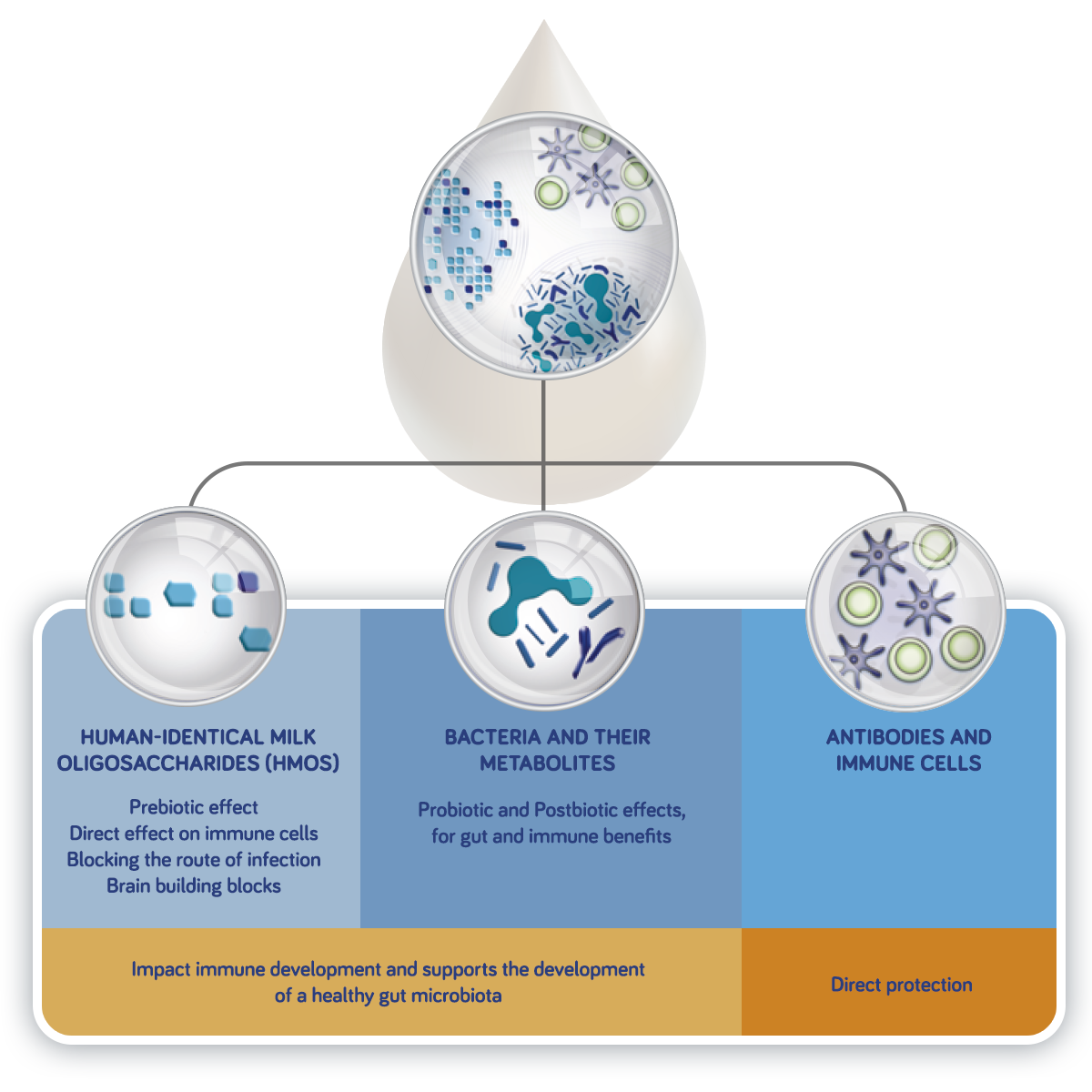
Image: The unique composition of breast milk – including its oligosaccharides, immune cells, bacteria, and bacterial metabolites – supports infant growth and development by promoting a healthy gut microbiota.
What is a human milk oligosaccharide (HMO)?
Human milk has been associated with the development of the immune system and human milk oligosaccharides play a crucial factor in the development of the intestinal microbiota. Oligosaccharides in mature human milk are present at a quantity of approximately 12 –15g/L representing the third largest component of human milk solids after lactose and fat.
The quantity of (12-15g/L) and diversity (approximately 200 identified HMOs in a ratio of 9:1) of oligosaccharides in human milk make them one of the most important components of human milk.
Infant formula is inspired by the complexities of breast milk
Breast milk is best – however for those infants that cannot or are not able to be breastfed, commercial infant formulae are recommended. Commercial Infant formulae seek to mimic the composition and functionality of breast milk as closely as possible, through the inclusion of biotics. Biotics are nutritionally active compounds that can, when consumed, confer a health benefit on the host.
The ‘biotic family’ in infant formula
The biotic family includes human identical milk oligosaccharides, prebiotics, probiotics and synbiotics. They offer promising opportunities for infant formula aiming to more closely resemble the composition and functionality of breast milk.
Biotics modulate the gut microbiota bringing it closer to that of a breast-fed infant.

Image: The definitions of Human Identical Milk Oligosaccharides, Prebiotics, Probiotics, and Synbiotics in a table.
Human Identical Milk Oligosaccharides in infant formula
There are some candidate prebiotics, prepared for infant formula that are structurally identical to their counterparts in human milk these are called human identical milk oligosaccharides (HiMOs). At present only 2’FL and LNnT are commercially available for the addition into infant formula.
HiMOs represent an interesting new field of study yielding promising results warranting further investigation. Of note is that 2’FL combined with scGOS*/lcFOS** (9:1) shows promising immune benefits in preclinical trials. Parents have also reported lower morbidity and medication use when LNnT is used in combination with 2’FL in infant formula.
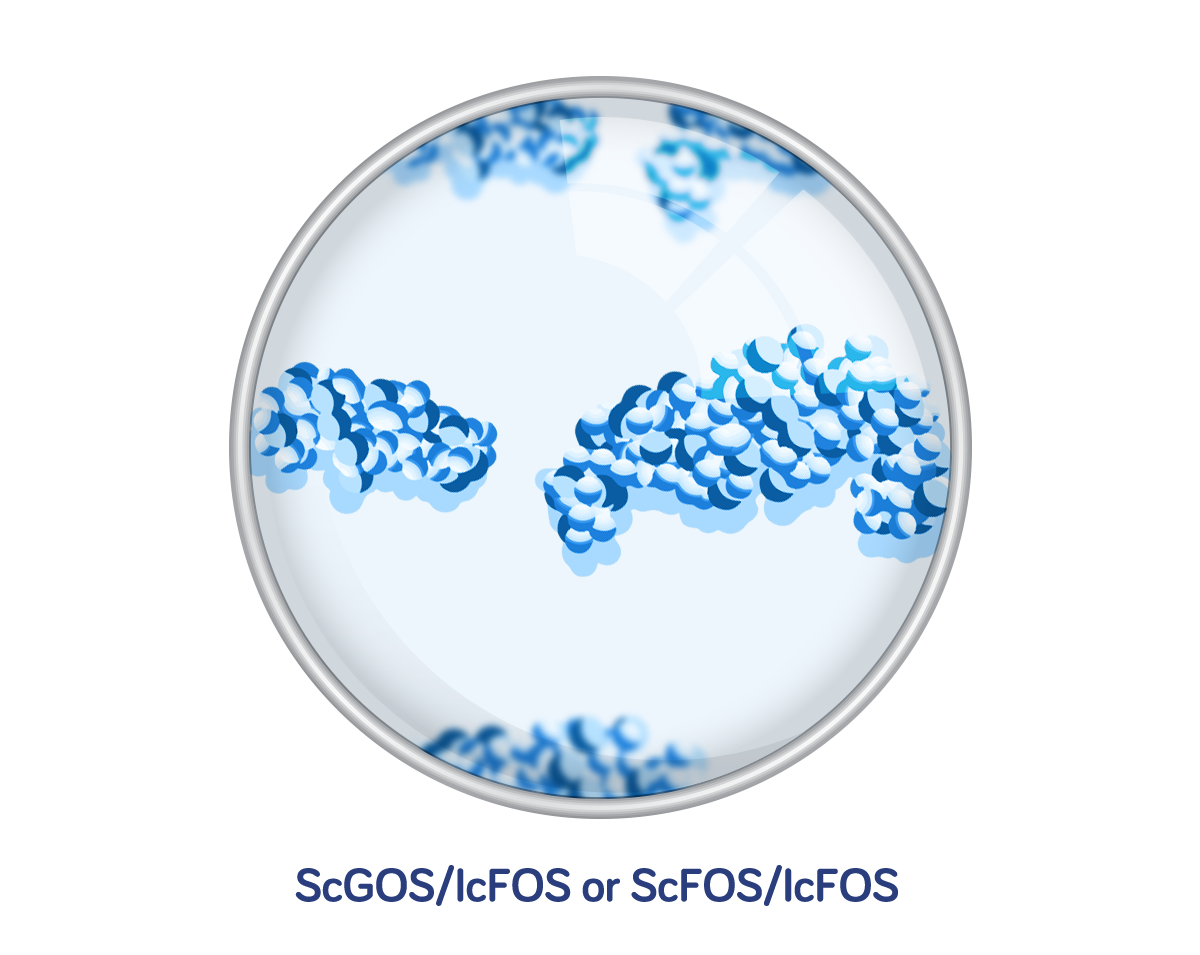
Prebiotics in infant formula
Prebiotics are non-digestible and arrive intact to the infant’s gut, they are a natural energy source for the healthy bacteria that are present in the intestine. Prebiotics feed the friendly bacteria in the gut helping the good bacteria to multiply. Not all prebiotics are the same, they are dose and type/combination dependent.
Prebiotics in infant formula are specifically designed to closely reflect the quantity, diversity (more than 100 different structures of short- and long-chain types in a ratio of (9:1) and functionality of HMOs in breast milk. The most studied prebiotic mixture available for infant formula is scGOS*/lcFOS** (9:1), it has more than 40 clinical studies and has shown positive effects on the gut microbiota, the immune system, infection rate reduction and stool softening. This mixture is recognised by the International scientific association for probiotics and prebiotics (ISAPP).
Probiotics in infant formula
Probiotics are live microorganisms which when administered in adequate amounts, confer a health benefit to the host. There are many different strains of probiotics that have been studied for their use in infant formula. Each strain of probiotic has different health benefits and are very specific. There are some probiotics that have been shown to reduce the risk of necrotising enterocolitis (NEC). Specific strains of Lactobacillus and Bifidobacterium are widely used as probiotics in infant formulae.
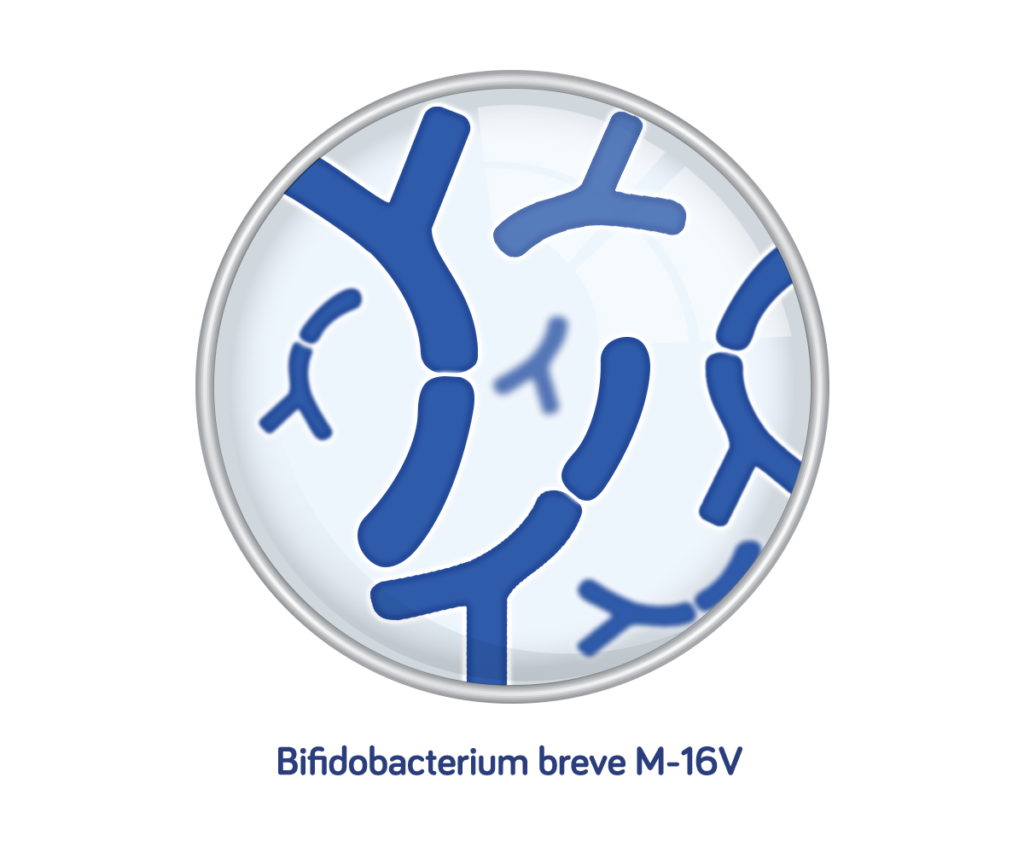
Synbiotics in infant formula
Synbiotics are a mixture comprising live microorganisms and substrate(s) selectively utilised by host microorganisms that confers a health benefit on the host.
The synbiotic mixture of prebiotics (scGOS*/IcFOS** or scFOS***/lcFOS** in a ratio of 9:1) and the probiotic strain Bifidobacterium breve M-16V showed promising results for infants at high risk of allergy and infants with already developed allergies.
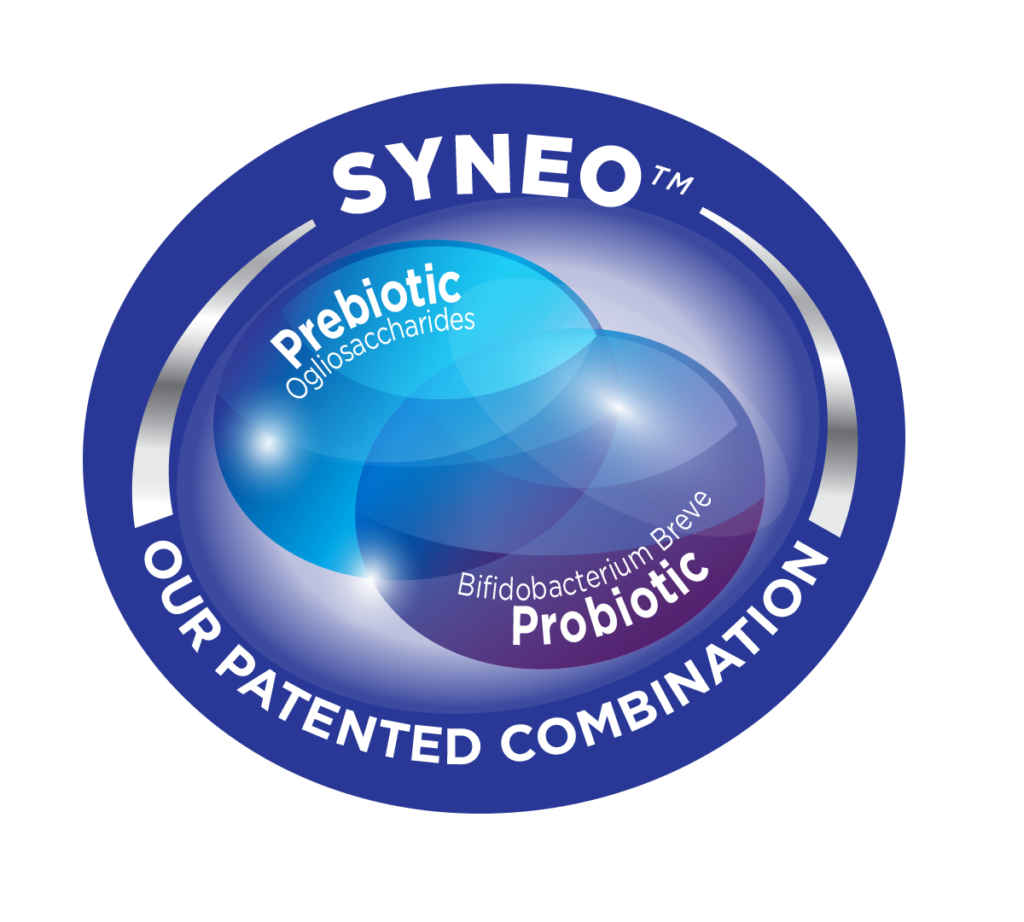
The synbiotic mixture of prebiotic scGOS/lcFOS(9:1) and probiotic Bifidobacterium breve M-16V compensated for delayed bifidobacteria colonisation and resulted in a lower proportion of potential pathogens (in infants delivered by caesarean section) leading to a significant decrease of atopic dermatitis (AD) score, less asthma-like symptoms and asthma medication use (in infants with AD).
In Summary:
Breastfeeding is the natural and optimal way of feeding an infant, but for those infants who are not able to be (fully) breastfed, the biotic family offers great and promising opportunities for infant formula aiming to more closely resemble the composition and functionality of breast milk.
Clinical Highlights: Prebiotics
Infant formula with the prebiotic mixture scGOS/lcFOS (9:1) is the most studied prebiotic, it has been recognised as a prebiotic by ISAPP (International Scientific Association for Probiotics and Prebiotics) and is endorsed by the World Allergy Organisation.
There are more than 40 clinical studies and more than 90 scientific publications to support this mixture and its benefits, alongside a translational research programme. Recently a group of independent experts published a paper stating that the mixture is in the range of human milk oligosaccharides close to human milk in quantity (8g/L) and diversity (more than 100 different structure of short- and long-chain types in a ratio of 9:1).
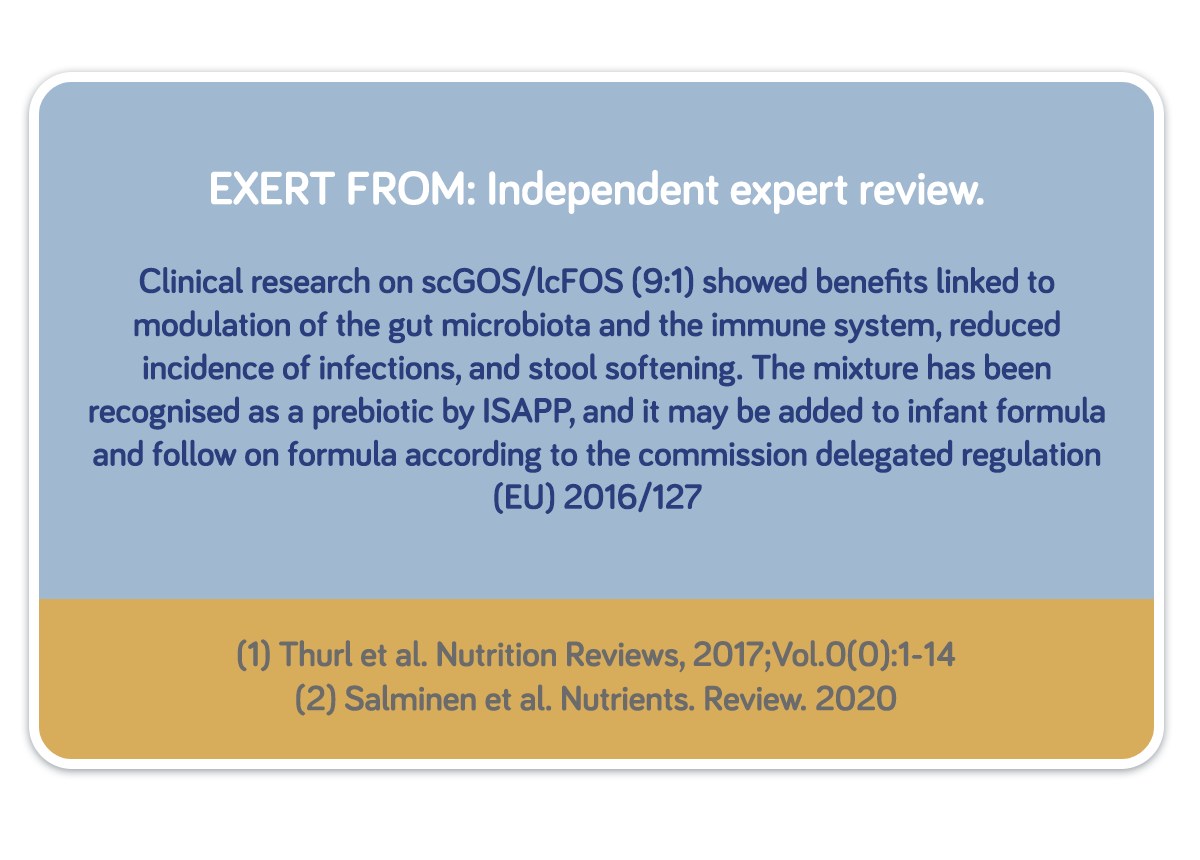
There are other prebiotic mixtures available in infant formula but scGOS/lcFOS (9:1) is the most studied and recognised prebiotic mixture commercially available.
Clinical highlights: Synbiotics
SYNEO is the only cow’s milk protein allergy (CMPA) range to contain our unique mix of pre and probiotics that work together to support the immune system. SYNEO contains a blend of beneficial bacteria (probiotic Bifidobacterium breve M-16V) from the same bifidobacteria family as those found in breast milk and the prebiotic oligosaccharide (scGOS*/IcFOS**(9:1) or scFOS***/lcFOS**) (9:1) that provide food for the beneficial bacteria. In three clinical trials in cow’s milk protein allergic infants, SYNEO has been shown to rebalance the gut microbiota, have fewer reports of infections and demonstrate consistent signals on a broad range of immune-related events.

Image: Benefits of Syneo on infant immunity, infection and rebalance of gut microbiota in 3 clinical trials on Cow’s Milk Allergy
References
Burks A, et al. Pediatr Allergy Immuno;,201526(4):316-22
Fox AT, et al. Clin Transl Allergy. 2019;9-5
Chatchatee P, et al. J Allergy Clin Immunol. 2021 Jul 2:S0091-6749(21)01053-8.
Candy D et al. Pediatr Res, 2018:83(3)677-86
Van der AA LB, et al. Clin Exp Allergy. 2010;40.795-804
Based on the following paper:
Salminen S et al. Infant Formula Supplemented with Biotics: Current Knowledge and Future Perspectives. Nutrients 2020, 12, 1952; doi10.3390/nu12071952
*short-chain galacto-oligosaccharides
**long-chain fructo-oligosaccharides
***short-chain fructo-oligosaccharides
Support for you and your patients
Join now and learn about our education events, research initiatives and evidence-based resources – furthering your professional development and clinical practice.
Support for you and your patients
Support for you and your patients
Join now and learn about our education events, research initiatives and evidence-based resources – furthering your professional development and clinical practice.



